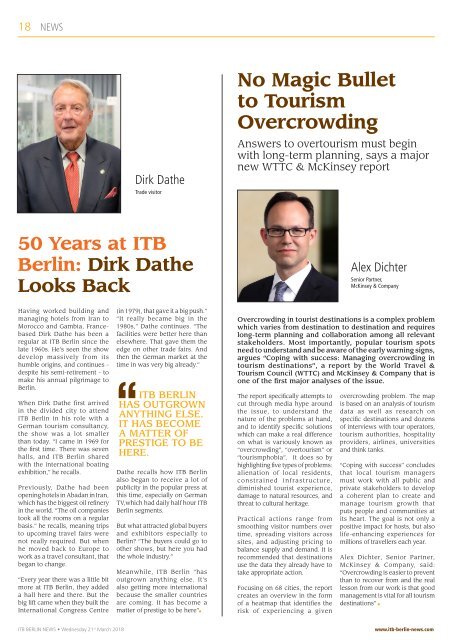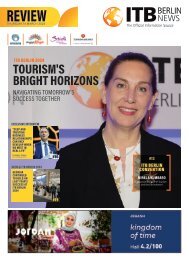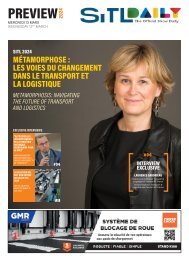You also want an ePaper? Increase the reach of your titles
YUMPU automatically turns print PDFs into web optimized ePapers that Google loves.
18 NEWS<br />
No Magic Bullet<br />
to Tourism<br />
Overcrowding<br />
Dirk Dathe<br />
Trade visitor<br />
Answers to overtourism must begin<br />
with long-term planning, says a major<br />
new WTTC & McKinsey report<br />
50 Years at <strong>ITB</strong><br />
<strong>Berlin</strong>: Dirk Dathe<br />
Looks Back<br />
Alex Dichter<br />
Senior Partner,<br />
McKinsey & Company<br />
Having worked building and<br />
managing hotels from Iran to<br />
Morocco and Gambia, Francebased<br />
Dirk Dathe has been a<br />
regular at <strong>ITB</strong> <strong>Berlin</strong> since the<br />
late 1960s. He’s seen the show<br />
develop massively from its<br />
humble origins, and continues -<br />
despite his semi-retirement - to<br />
make his annual pilgrimage to<br />
<strong>Berlin</strong>.<br />
When Dirk Dathe first arrived<br />
in the divided city to attend<br />
<strong>ITB</strong> <strong>Berlin</strong> in his role with a<br />
German tourism consultancy,<br />
the show was a lot smaller<br />
than today. “I came in 1969 for<br />
the first time. There was seven<br />
halls, and <strong>ITB</strong> <strong>Berlin</strong> shared<br />
with the international boating<br />
exhibition,” he recalls.<br />
Previously, Dathe had been<br />
opening hotels in Abadan in Iran,<br />
which has the biggest oil refinery<br />
in the world. “The oil companies<br />
took all the rooms on a regular<br />
basis.” he recalls, meaning trips<br />
to upcoming travel fairs were<br />
not really required. But when<br />
he moved back to Europe to<br />
work as a travel consultant, that<br />
began to change.<br />
“Every year there was a little bit<br />
more at <strong>ITB</strong> <strong>Berlin</strong>, they added<br />
a hall here and there. But the<br />
big lift came when they built the<br />
International Congress Centre<br />
(in 1979), that gave it a big push.”<br />
“It really became big in the<br />
1980s,” Dathe continues. “The<br />
facilities were better here than<br />
elsewhere. That gave them the<br />
edge on other trade fairs. And<br />
then the German market at the<br />
time in was very big already.”<br />
<strong>ITB</strong> BERLIN<br />
HAS OUTGROWN<br />
ANYTHING ELSE.<br />
IT HAS BECOME<br />
A MATTER OF<br />
PRESTIGE TO BE<br />
HERE.<br />
Dathe recalls how <strong>ITB</strong> <strong>Berlin</strong><br />
also began to receive a lot of<br />
publicity in the popular press at<br />
this time, especially on German<br />
TV,which had daily half hour <strong>ITB</strong><br />
<strong>Berlin</strong> segments.<br />
But what attracted global buyers<br />
and exhibitors especially to<br />
<strong>Berlin</strong>? “The buyers could go to<br />
other shows, but here you had<br />
the whole industry.”<br />
Meanwhile, <strong>ITB</strong> <strong>Berlin</strong> “has<br />
outgrown anything else. It’s<br />
also getting more international<br />
because the smaller countries<br />
are coming. It has become a<br />
matter of prestige to be here”<br />
Overcrowding in tourist destinations is a complex problem<br />
which varies from destination to destination and requires<br />
long-term planning and collaboration among all relevant<br />
stakeholders. Most importantly, popular tourism spots<br />
need to understand and be aware of the early warning signs,<br />
argues “Coping with success: Managing overcrowding in<br />
tourism destinations”, a report by the World Travel &<br />
Tourism Council (WTTC) and McKinsey & Company that is<br />
one of the first major analyses of the issue.<br />
The report specifically attempts to<br />
cut through media hype around<br />
the issue, to understand the<br />
nature of the problems at hand,<br />
and to identify specific solutions<br />
which can make a real difference<br />
on what is variously known as<br />
“overcrowding”, “overtourism” or<br />
“tourismphobia”. It does so by<br />
highlighting five types of problems:<br />
alienation of local residents,<br />
constrained infrastructure,<br />
diminished tourist experience,<br />
damage to natural resources, and<br />
threat to cultural heritage.<br />
Practical actions range from<br />
smoothing visitor numbers over<br />
time, spreading visitors across<br />
sites, and adjusting pricing to<br />
balance supply and demand. It is<br />
recommended that destinations<br />
use the data they already have to<br />
take appropriate action.<br />
Focusing on 68 cities, the report<br />
creates an overview in the form<br />
of a heatmap that identifies the<br />
risk of experiencing a given<br />
overcrowding problem. The map<br />
is based on an analysis of tourism<br />
data as well as research on<br />
specific destinations and dozens<br />
of interviews with tour operators,<br />
tourism authorities, hospitality<br />
providers, airlines, universities<br />
and think tanks.<br />
“Coping with success” concludes<br />
that local tourism managers<br />
must work with all public and<br />
private stakeholders to develop<br />
a coherent plan to create and<br />
manage tourism growth that<br />
puts people and communities at<br />
its heart. The goal is not only a<br />
positive impact for hosts, but also<br />
life-enhancing experiences for<br />
millions of travellers each year.<br />
Alex Dichter, Senior Partner,<br />
McKinsey & Company, said:<br />
“Overcrowding is easier to prevent<br />
than to recover from and the real<br />
lesson from our work is that good<br />
management is vital for all tourism<br />
destinations”<br />
<strong>ITB</strong> BERLIN NEWS • Wednesday 21 st March <strong>2018</strong><br />
www.itb-berlin-news.com

















